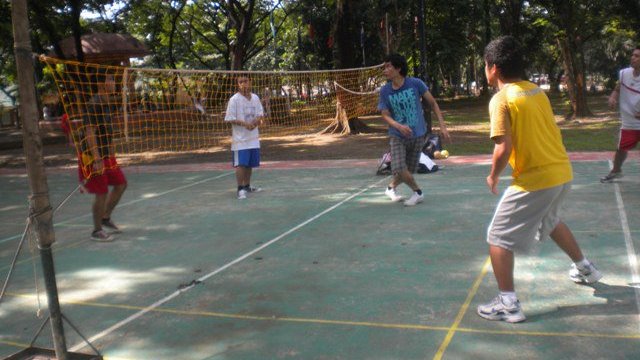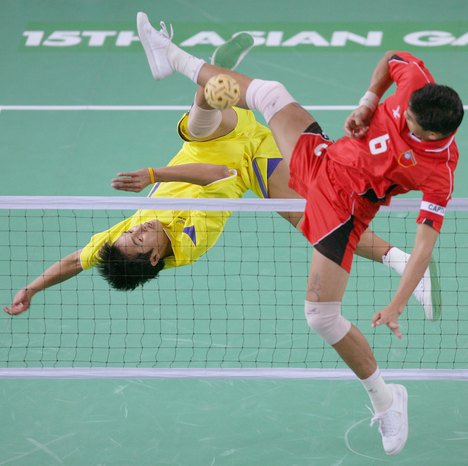SUMMARY
This is AI generated summarization, which may have errors. For context, always refer to the full article.

MANILA, Philippines – For the longest time, sipa has been labeled as the national sport of the Philippines. Well, not anymore.
From being the “national sport,” sipa is now more commonly described as the “Philippines’ favorite traditional native sport.”
This, perhaps, is a more accurate description, given that there are still a big number of Filipinos who prefer sipa more than any other traditional Filipino game. It is already a big part of the Philippine culture (and for some Filipinos, their childhood), since it was considered the national sport since time immemorial.
Stripped of its title, however, it seems like a lot of Filipinos do not really understand this sport. There is actually more to sipa than simply being a kid’s street game.
Understanding sipa
Sipa, which literally means “to kick,” is simple. The objective is to keep the “pato” in the air as long as the player can without using any other body part aside from the legs.
The player kicks the ball in such a way that the opponent will have a difficult time returning it. The last kick usually requires a certain height or distance from the player. Points are also counted against a player or team.
Simpler rules are used during street play. In these games, the players may tweak the rules depending on what they have agreed upon.
For example, some street plays of sipa have no definite court size and number of players.
Sipa and sepak takraw
It is a common misconception that sepak takraw is the same as sipa.
In some instances, sepak takraw is used synonymously with sipa since the 2 games actually have very similar rules and regulations. Although closely related, in terms of its origins and dynamics, the 2 sports are actually distinct.
The biggest difference, perhaps, is that sipa was our actual national sport while sepak takraw is a similar sport played mostly in Malaysia, Thailand, and other neighboring countries.
A sepak game also would require teams of 3 to play it while sipa is more flexible in terms of the number of players and the scoring system.
Sepak has been called kick volleyball because its rules are similar to the latter except that players use their heads, legs and feet, instead of their hands.

This sport is internationally renowned with organizations like the International Sepak Takraw Federation governing it. Many countries have sepak takraw teams competing in tournaments worldwide.
The King’s Cup World Championships for sepak takraw are also held in Thailand annually.
Changing sports
When former President Gloria Macapagal-Arroyo approved Republic Act 9850 — an Act declaring arnis as the national martial art and sport of the Philippines on Dec 11, 2009 — many people reacted negatively, questioning the change.
Sipa had occupied a place in the subconscious of Filipinos as a people, that it has become the automatic answer whenever Pinoys enumerate the national symbols.
It’s one thing, however, to know the national game and it’s another thing to practice it.
Did Filipinos really know sipa? Was sipa the national game in practice or was it just something Pinoys knew at the back of their minds?
Perhaps, this is one of the reasons why sipa was replaced by arnis.
Elementary schools taught students that sipa is the national sport but it stopped at that. More schools include arnis in their curricula; hence, more students familiarized themselves with arnis more than sipa.
Another possible reason for the change is that arnis generates more interest than sipa.
The country has arnis grandmasters, and numerous arnis schools and clubs across the country. The Philippines has very few for sipa — if there at all — and most of them practice sepak takraw.
Being a martial art, arnis breeds more competition among individuals.
This is a big factor especially for a country that is fond of contact sports like boxing.
Need to get the rattan ball rolling
Sepak takraw has been a regular sport in the Asian Games and the Southeast Asian Games.
The national sepak takraw team — yes, there is one — competes in these international games. Although training almost under anonymity, the team trains hard to bag awards in international competitions.
Sipa and sepak takraw are 2 sport events that are played in the Palarong Pambansa 2012.
Elementary and high school students from the different regions of the Philippines will compete in these 2 team events come May 6-12.
The inclusion of the 2 sports in the nationwide games means that despite the change of national sports, a bright future is possible for sipa and sepak takraw.
Hopefully, the Filipino youth will continue to see the value of traditional Filipino games so that sipa will not be forgotten. Hopefully too, Pinoys excel at what was once hailed as the country’s national sport. – Rappler.com
Add a comment
How does this make you feel?
There are no comments yet. Add your comment to start the conversation.